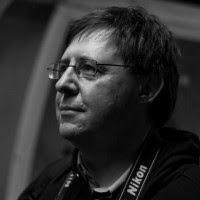Hmm, been too long since I wrote. So here is a short note about a recent photo, since I had a few questions about how it was created.
This is a photo of Ray Huntly, who coordinates all the photo competitions at the Melbourne Camera Club. The photo was taken during a meeting of the Digital Group - I was presenting a talk on GIMP, and needed a photo to manipulate to illustrate the discussion, so took this one.
Now, the people there saw me take the photo, so they knew exactly the lighting set up I used, but I still ended up spending 5-10 minutes explaining why the photo looks like it does.
The lighting set up was quite simple - one flash firing into a reflective umbrella off to camera right.
The two main questions that arose were:
- Since there was only one light, why is the left side (as we look at the photo) not in darkness?
- There was quite a bit of ambient light in the room, why is the background totally black?
The answers are a little bit related: if there was enough ambient light to avoid darkness on the left side of the photo, why was there not enough for us to see the room Ray is standing in?
To look at the first one first - I had carefully placed the set up next to a wall off to camera left (a wall that happens to have light coloured canvas on for mounting pictures for competitions and exhibitions). The flash on camera right hit the wall, and the soft covering on the wall reflected it back to light camera left. Obviously, it is dimmer than the direct light, but provides enough light to avoid very dark shadows on that side of the photo. Also note that the reflection comes from a large area of the wall, so the light is quite soft.
As for the background... The photo was taken at a relatively fast shutter speed (1/200 sec), and the flash was relatively much brighter than the ambient light in the room. Combine that with the fact I was using a reflective rather than shoot through umbrella, so I was able to direct the light where I wanted it without too much spilling in to the rest of the room. At that shutter speed there was not enough time for the ambient light to make any impression on my camera's sensor.
Thanks to David Gilliver, who explained the concept of lighting zones to me. That is essentially what is at work here: there is the foreground zone, where the light from the flash is contained, and the background zone, which has light in it, but not enough relative to the foreground zone to register.
Addendum - this photo won a "Highly Commended" award in the Melbourne Camera Club August 2009 EDI competition.


No comments:
Post a Comment